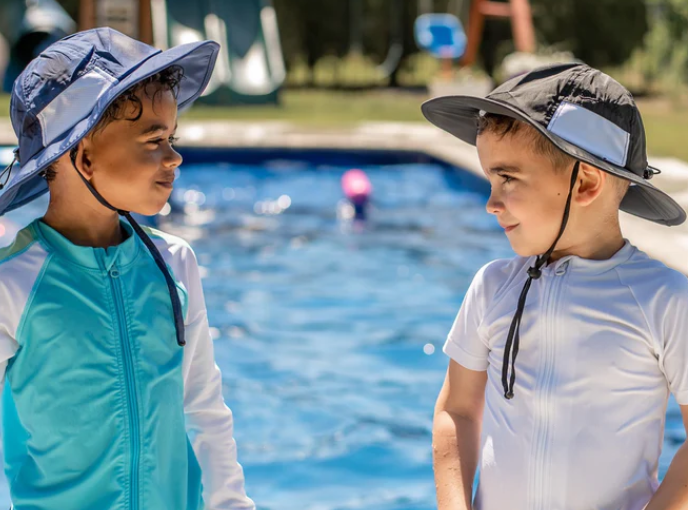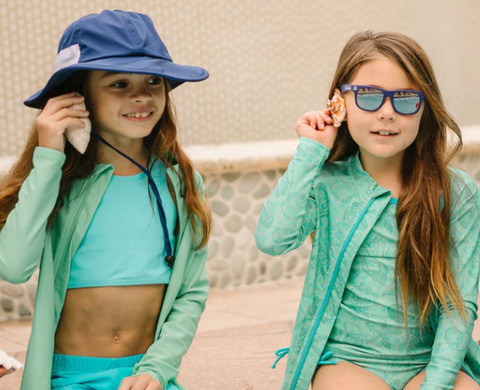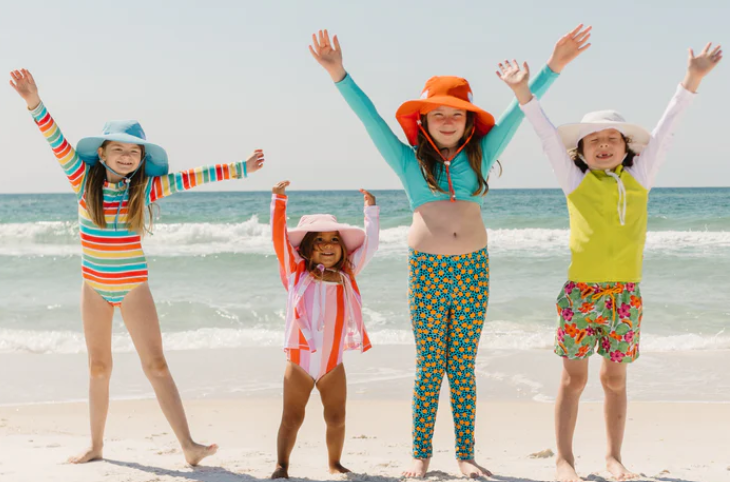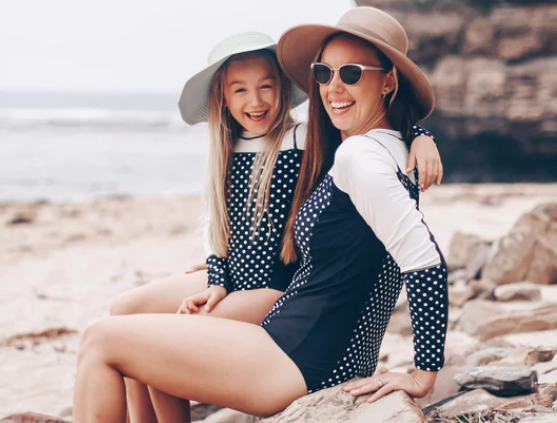
UPF vs. SPF: what’s the difference?
The main difference between UPF and SPF is that UPF (ultraviolet protection factor) measures the amount of UV radiation that can penetrate fabric and reach your skin, while SPF (sun protection factor) refers to the time it takes for skin exposed to UV radiation to turn red.
UPF indicates how much ultraviolet radiation a fabric allows to pass through to the skin. Clothing with higher UPF ratings, up to 50+, has more UV ray-blocking potential.
SPF measures the effectiveness of sunscreens in preventing sunburn, and more specifically, how effectively they protect against UVB rays.
UPF refers to the level of protection provided by clothing and textiles against UVA and UVB radiation. SPF measures the level of protection that sunscreens provide against UVB rays, and their ability to reduce the risk of sunburn.
Quick links:
Difference between UVA and UVB rays
Why is sun-protective clothing important?
Read on to learn more about the difference between these two ratings, and how to protect yourself from UV radiation.
UPF rating system
The UPF rate indicates how much of the sun's UV radiation is absorbed by the fabric. Fabrics are assigned a UPF rating number based on how much UV radiation can pass through them and reach the skin.
For example, a fabric rated UPF 30 allows only 1/30th (3.33%) of UV rays to penetrate, blocking 96.67% of radiation. Meanwhile, a UPF 50+ fabric allows less than 2% of UV rays through by blocking over 98%.
The key UPF rating ranges are:
- 15—24: good UV protection
- 25—39: very good UV protection
- 40—50+: excellent UV protection
Higher UPF numbers signify better skin protection from sunburns, skin damage, and the development of skin cancer. UPF measures a fabric’s effectiveness in protecting against both UVB and UVA radiation.
The table below illustrates the different UPF protection ranges and the percentage of UV blocked.
|
Category |
UPF range |
UPF values allowed on labels |
% of UV blocked |
|
Good UV protection |
15—24 |
15 and 20 |
93.3%—95.8% |
|
Very good UV protection |
25—39 |
20, 30, and 35 |
96.0%—97.4% |
|
Excellent UV protection |
40—50+ |
40, 45, 50, and 20+ |
97.5%—98% |
SPF rating system
The SPF rating system measures a sunscreen's ability to prevent sunburn caused by ultraviolet B (UVB) rays. The higher the SPF number, the greater the percentage of UVB rays the sunscreen filters out:
- SPF 15 blocks 93% of UVB rays
- SPF 30 blocks 97%
- SPF 50 blocks 98%
- SPF 50+ blocks 98+%
While no sunscreen can block 100% of UVB rays, the American Academy of Dermatology considers SPF 30 to be the minimum recommended level of sun protection.
The FDA requires sunscreen products to be tested to validate that they meet their labeled SPF rating. The SPF rating system allows people to compare products and choose the right sunscreen to suit their sun protection needs.
What is the difference between UVA and UVB rays?
Ultraviolet A (UVA) rays have longer wavelengths and are associated with skin aging. Ultraviolet B (UVB) rays have shorter wavelengths and are associated with sunburns.
The main differences between UVA and UVB rays are:
UVA rays:
- Longer wavelength UV rays can penetrate deeper into the skin than UVB
- Primarily responsible for skin aging, wrinkling, and indirect skin DNA damage that increases the risk of skin cancer
- Pass through glass and cloud cover
- Present with consistent intensity during all daylight hours
UVB rays:
- Shorter wavelength UV rays that only penetrate the outermost layers of skin
- Directly damages skin DNA leading to sunburns and skin cancer
- Associated with dark tans
- Blocked by glass but not clouds
- Most intense between 10 am—2 pm
Why is sun-protective clothing important?
Here are a few key reasons why sun-protective clothing is important:
- Prevent sunburn and skin damage. Clothing with a high UPF rating can protect skin from both UVA and UVB rays, and prevent painful sunburns and skin cell damage that can lead to the development of skin cancer over time.
- Avoid chemicals from sunscreen. Sun-protective fabrics provide a chemical-free barrier of protection compared to sunscreens. This can be beneficial for those with sensitive skin who react to lotions.
- Protection when swimming or sweating. Unlike sunscreen, protective clothing doesn't wash off in water or sweat. The protection remains consistent through pool swim sessions, beach days, or sports games.
- Suppresses UV exposure. Tightly woven, lightweight fabrics inhibit over 95% of the sun's UV radiation from penetrating the skin. This decreases the chances of sun damage and skin cancer risks.
- Comfortable cover. Innovations such as stretch, ventilation, and UV-resistant dyes make sun-protective fabrics cooler and more comfortable in hot weather compared to normal clothing.
Sun-protective accessories
In addition to sun-protective clothing, accessories like sun hats and sunglasses add further ultraviolet protection.
At SwimZip, we sell wide-brimmed sun hats that shade the highly exposed face, ears, and neck areas. These sun hats are made with UPF 50 fabric for maximum protection. They are made of polyester to provide comfort and breathability on top of UV protection.

Sunglasses serve as another line of defense against UV exposure that can cause cataracts and other long-term damage. Our sunglasses have 100% UV protection lenses to provide maximum defense against UVA and UVB.
The lens is polarized, which uses a chemical filter to neutralize glare, enhancing visual clarity on water or snow.
Combine protective clothing with quality accessories to optimize skin, face, and eye coverage. This way, you will minimize the risks posed by exposure to UV radiation and can enjoy sun-safe fun.
For example, this stylish wide brim sun hat keeps kids shady and looking good while they play.
Combine sunscreen with fabrics
Using sun-protective fabrics rated with a UPF will shield your skin from the sun's harsh rays. But for times of prolonged exposure, additional precautions should be utilized.
In situations where sunlight exposure exceeds one hour, broad-spectrum sunscreen should be used to complement the coverage of UPF-rated clothing. Apply water-resistant sunscreen twenty minutes before going out. Use enough to cover all areas not shielded by technical fabric garments.
Reapply sun lotion every two hours as recommended by the American Academy of Dermatologists. Even highly rated UPF garments will leave spots like the face exposed.
Combine UPF-rated clothes with the additional protection of chemical-based or sunscreens to get maximum protection against UV rays in high-risk areas like the face. Enjoy your summer months without risking overexposure and related health issues.
Stay safe with SwimZip
Here at SwimZip, we’re dedicated to promoting sun-safe fun by developing and delivering sun-protective swimwear that is stylish, functional, and affordable. We have become one of the most trusted UPF 50+ brands that people use to keep themselves and their loved ones safe from the sun.
We are proud to present our new collection of neon swimsuits! Besides being fun and bright, our neon colors stand out for extra visibility and another element of safety while out and about.
These vivid neons are some of the best swimsuit colors for safety—and they are just too cute! We also offer swim dresses, tankini tops, swim trunks, rash guards, and more.
UPF vs. SPF FAQ
Which fabric has the highest UPF?
The fabrics with the highest UPF ratings are usually lightweight, tightly woven textiles that use special UV-resistant treatments. Some examples are polyester, nylon, lyocell, and treated cotton, which can achieve UPF 50+ blocking 98% of UV radiation from penetrating the fabric onto the skin.
What is the healthiest SPF to use?
The healthiest SPF to use is SPF 30, which blocks 97 percent of UVB rays. SPF 30 is the minimum recommendation from organizations like the Skin Cancer Foundation because it balances sufficient sunburn protection with fewer chemicals compared to higher SPF options.
What color is the best for UPF?
The best color for UPF is dark blue, as it offers the highest levels of UV protection. Darker and more intense colors tend to have better UV radiation protection than lighter colors because they absorb more UV light and prevent it from reaching the skin.
Should I wear sunscreen under UPF clothing?
You should wear sunscreen under UPF clothing to cover any small areas of skin not shielded by the fabric weave like the neck and tops of feet. Reapply waterproof sunscreen every 2 hours under the clothing for full protection when sweating or getting wet.
Does UPF clothing work when wet?
UPF-rated clothing retains its protective qualities even when wet. As long as the fabric is not transparent when wet and maintains coverage over the skin, its ability to block UVA and UVB rays does not diminish.
Can you get sunburned through UPF 50?
It is unlikely to get sunburned through properly certified UPF 50 fabric, which blocks 98% of UV radiation. However, small areas like the neck may be exposed to gaps in coverage. Sunburn could occur as a result of extensive sun exposure if not wearing sunscreen in vulnerable zones.
Does UPF protection wash out?
UPF protection does not generally wash out because it is often embedded into the chemical structure of the textile fibers. UPF treatments are designed to withstand standard laundering and normal wear over the lifespan of the clothing item without losing effectiveness.
Is UPF 30 enough?
UPF 30 provides good sun protection blocking over 95% of UV rays, but UPF 50+ is better. UPF 30 may be suitable for brief intermittent outdoor activities, while UPF 50+ gives maximum skin protection for all-day sunlight which is the safest choice.
Is black or white better for sun protection?
Black or other dark colors are better for sun protection than white, according to Cancer Council Australia. Dark colors, such as black, brown, navy, and dark green, absorb more UV rays and prevent them from reaching the skin, whereas white and lighter colors offer less protection.
Helpful information
Resources
Sunscreen FAQs. (n.d.). American Academy of Dermatology. Retrieved February 22, 2024, from https://www.aad.org/media/stats-sunscreen
Sun protective clothing. (n.d.). Cancer Council. Retrieved February 22, 2024, from https://www.cancer.org.au/cancer-information/causes-and-prevention/sun-safety/be-sunsmart/sun-protective-clothing



Leave a comment
This site is protected by hCaptcha and the hCaptcha Privacy Policy and Terms of Service apply.